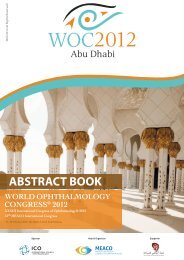ScientiËc Program - WOC2012
ScientiËc Program - WOC2012
ScientiËc Program - WOC2012
Create successful ePaper yourself
Turn your PDF publications into a flip-book with our unique Google optimized e-Paper software.
Scientific <strong>Program</strong><br />
CO-COR-SA 250<br />
Sat 18 Feb<br />
15:30 - 17:00 Capital Suite 8<br />
Towards a Safer Refractive Surgery<br />
Presenters: Tamer Gamaly, Tarek Abd El Samie, Islam Hamdi,<br />
Mohamed Abd El Rahman<br />
Objective: Course will describe different refractive surgery<br />
complications. Laser refractive surgeries including surface<br />
ablations, LASIK or FS laser, as well as non laser RS as phakic IOL's<br />
(different types) or ICRS. Possible management of these<br />
complications will be also discussed. Attendee at the end of this<br />
course will realize the possible complications of each procedure<br />
and the available management of such complications.<br />
Summary of Content:<br />
Introducation: Tamer Gamaly 5 min.<br />
Surface ablation complications: Tarek Abd El Samie 10 min.<br />
Intrastromal laser complications: Mohamed Abd El Rahman 10 min.<br />
ICRS complications: Islam Hamdy 10 min.<br />
Phakic IOL's complications: Tamer Gamaly 10 min.<br />
Discussion: All speakers 5 min.<br />
Target Audience: Refractive Surgery subspecialists<br />
Educational Level: Intermediate<br />
CO-LOW-SA 251<br />
Sat 18 Feb 15:30 - 17:00 Capital Suite 9<br />
Low Vision Basics<br />
Presenter: Sanjiv Desai<br />
Saturday, 18 February 2012<br />
This is a basic level instruction course for ophthalmologists,<br />
which focuses on imparting appropriate skills in clinical low<br />
vision. The objective of the course is to impart skills in assessing<br />
low vision cases in the clinic and how to dispense low vision aids<br />
[LVA]. It begins by defining low vision and describing the<br />
common ophthalmic conditions leading to low vision. Then the<br />
cardinal principles of treating low vision are described, followed<br />
by exploring various types of optical and non-optical low vision<br />
aids [LVA] available in the market to enhance visual performance,<br />
their optics, their advantages and disadvantages and how to use<br />
them. Finally the course is wound up by discussing how to assess<br />
a low vision patient in the clinic and how to dispense low vision<br />
aids. At the end of the course, participants will become proficient<br />
in identifying and treating low vision cases in their day-to-day<br />
practice, thus, integrating low vision care into their clinical<br />
practice.<br />
76






